A funny thing happened on the way to the City of Portland’s Transportation System Plan update: The Bureau of Transportation proposed to downgrade their goal for the percentage of commute trips made by bicycle users from 25 to 15 percent.
Huh? Aren’t we a “Platinum” bike-friendly city? Shouldn’t we embrace this challenge and not cower away from it?
That “target mode share” is a key performance measure that helps city planners set priorities. The “25 percent by 2035” mantra has been a rallying principle for bike advocates since it was formally adopted as the goal for all bicycle trips (not just work trips) in the Bike Plan and subsequently in the Climate Action Plan. Drafters of the TSP update initially copy-pasted the number. Then the city’s Planning Commission asked PBOT to analyze a new “work from home” mode share target which had never been used before. This spurred a new analysis of the biking mode share targets and PBOT began to feel the 25 percent goal was unattainable and proposed the downgrade as a result of a new “evidenced-based approach” that would be more “realistic and achievable.”
But many bike policy insiders and advocates cringed at the idea. Regardless of the details and policy underpinnings, on the surface it seemed like a capitulation — especially for an agency that continues to struggle with complacency and stagnation.
We’re happy to report that they’ve reversed course and the 25 percent goal is back. That might be because PBOT’s own advisory committee opposed the change.
On August 11th the Bicycle Advisory Committee wrote a letter to PBOT Director Leah Treat. “The BAC believes that reducing the commute mode share goal for bicycling from 25% to 15% may diminish the priority that should be placed on investing in bicycling infrastructure as the most cost-effective way to meet the City’s goal of reducing drive-alone trips,” read the letter (the goal for non drive-alone trips is 70 percent).
Advertisement
Here’s more from the BAC letter:
“Reducing the goal mode share for bicycling detracts from the fact that bicycling has made further strides towards meeting these mode split goals since 2000 than any other mode of transportation. Commute mode share data from the US Census Bureau shows that Portland’s efforts to increase bicycling have been more effective than other other modes, at a relatively low cost.
Between 2000 and 2015, bicycle commute mode share in Portland increased dramatically from 1.8% to 7%, while transit mode share increased slowly from 12.3% to 13.3%. Carpool mode share decreased from 11.9% to 8.2%, while walking mode share increased from 5.2% to 6%. The BAC supports investment in all non-drive alone modes, but believes the City should develop goals and policies that support and prioritize the most effective and efficient investments. A basic comparison of capital investment and changing mode choice by Portland residents in the last two decades shows that bicycling infrastructure has been, dollar for dollar, the best transportation investment strategy by the City of Portland.”
PBOT appears to have taken the BAC’s feedback (and likely the emails and comments from others) to heart. One week after the BAC’s letter to Director Treat the latest draft of the TSP update was released (PDF). They’ve dropped the 15 percent idea, restored the higher 25 percent target, and have included some rather inspiring language about what it will take to get there…
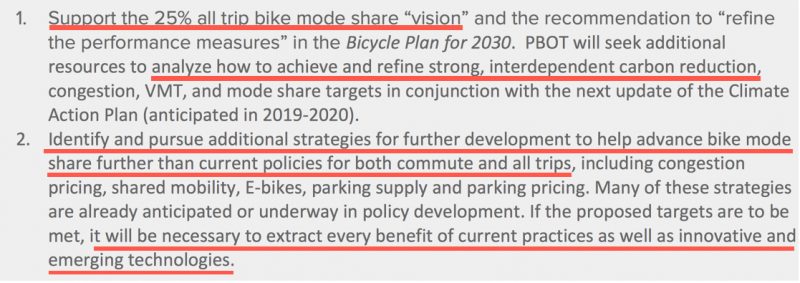
PBOT Communications Director John Brady shared with us today that Director Treat led a conversation at the bureau about the issue. “She felt the 25 percent target was important as a stretch goal for the bureau to work towards,” Brady said, “And thus she directed staff to retain it.”
From here the TSP update will go back in front of the Planning & Sustainability Commission on September 26th. You can testify at that hearing and/or email comments to the PSC until that date. Learn more at the TSP update website.
— Jonathan Maus: (503) 706-8804, @jonathan_maus on Twitter and jonathan@bikeportland.org
Never miss a story. Sign-up for the daily BP Headlines email.
BikePortland needs your support.


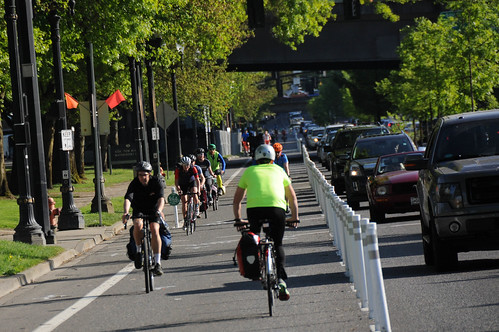
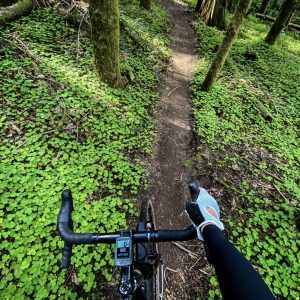
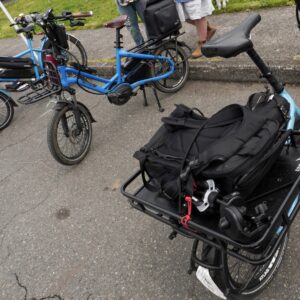

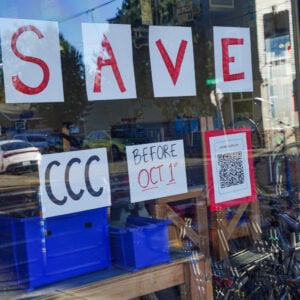
Thanks for reading.
BikePortland has served this community with independent community journalism since 2005. We rely on subscriptions from readers like you to survive. Your financial support is vital in keeping this valuable resource alive and well.
Please subscribe today to strengthen and expand our work.
Glad to see our eye is back on the ball.
Yay! The goal is unrealistic, but better to aim high and fall short than not try at all.
The goal only appears unrealistic if we assume the future will be a tidy extrapolation of the past. Plenty of signs suggest this might not be the wisest assumption to make. Personally I think assuming auto-mode share will be anything like what it is today in 2035 is what is unrealistic. But most of you already knew that 😉
A glimmer of hope…could Portland be getting its bike mojo back?!!
No.
Definitely not until they start making good on their promises to better connect the east side of the city to the inner city. Until then it’s all rainbows and hot air.
word.
Also – I’m not sure any promises this effect have been made, but – better connections from East Portland to East Portland residents’ employment centers, at least the close-by ones (Columbia Corridor, Clackamas Town Center, downtown Gresham) are key.
The Clackamas Town Center connection is already passable due to the I-205 path, and could be made good by fixing the Flavel St. gap and somehow substantially reducing antisocial behavior (blocking the path, littering) by a small minority of homeless folks. Somehow getting Clackamas County to put in good bike infrastructure *around* the Clackamas Town Center area would also be needed to get to “great.”
There are already some good trail connections *to* downtown Gresham (Springwater Trail, MAX path) but the first three miles (to the paths) and the last mile (from the path to the employment destination)
Plus, the main metric should be percent of *all* trips, not percent of commute trips.
There is a pretty big gap between the Columbia river and the Springwater for anyone east of I-205. Better east/west connections are needed there for sure. At least the abysmal Halsey/I205 overpass there I guess.
Maybe someone at PBOT has read some of the reports coming out from thinkers in the oil industry, the IEA and Saudi Aramco that oil supplies will soon be in a permanent crunch and perhaps 25% for bikes is realistic as the petroleum powered auto’s share drops by the wayside.
http://www.argusmedia.com/news/article/?id=1449742
Good, now perhaps someone at PBOT can get working on a way to spend a reasonable amount of funds on bike infrastructure. By this I mean a non-trivial amount (>10%) and back it up with prioritizing efficient and practical routes rather than caving when parking spaces or passing lanes get in the way. You aren’t going to hit 25% mode share if the 2030 bike plan is only 25% complete in 2035 (though this would represent an improvement upon the current pace).
This is great news…
…as long as the City leadership doubles down: backs it up with the on-going budget AND political guts to do “cheap” but often politically risky safety tweaks like removing on street parking/ extra through lanes vs. longer term street reconstruction widening.
Like revisiting older arterial projects that are “half” done per bikeway / transportation safety like the “old” Interstate corridor which got dialled back before construction due to political pushback on the Yellow Line.
And as a planner, I would also strongly recommend interim modal objectives be officially set for every 2 or 3 years…so that regular status check ins can be done vs waiting for all the success and effort be focused on the last 5 years after 2025…then its a crisis [or a punt at cancelling the goal again.]
Miles of PBL is directly proportional to % of people on bikes.
I hear it’s also proportional to right-hook collisions.
Indeed you may be correct. In the US we tend to assume the omission of the protected intersection, which should go hand in hand.
Way to bring back one of my favorite michael anderson posts 🙂
The 25 percent bike mode share is completely unrealistic. It’s far better (and more realistic) for me to have a goal of commuting to work 200 times during the year or riding 3000 miles than it is for me to set a goal of winning the Tour de France. Why not set something realistic and still a bit beyond what’s likely?
We should be trying to win the Tour de France….
Why not. We are flooding and burning away.
I’d like you to say more about how unrealistic this strikes you, J_R.
As I noted above, if we look to the past as a guide, assume that future mode share will be determined by preferences/preference changes, then it does seem unrealistic, but I think those assumptions are less realistic than a 25% bike mode share by 2035, though I differ with PBOT on the reasons and circumstances of that accomplishment.
My read of the simulation was that Portland would need to completely overhaul its infrastructure and housing structure, the latter because the city is simply not dense enough. We keep comparing us with European cities but their density is 2-3 times higher than Portland. I do not see how we can even remotely get to a markedly higher density in 13 years. And infrastructure projects like the 20s bikeway do not make me feel optimistic about sweeping infrastructure changes, either.
Yeah, the 20s feels pretty half-assed. We can and must do better.
It’s all just talk-talk until there are verifiable checkpoints with real metrics and consequences for failure. For instance, at the three year mark, if one-tenth of the needed growth in cycling hasn’t occurred (pick a number), that should cause a doubling in the percentage of city funds that go to cycling infrastructure (include social infrastructure like traffic law enforcement directed at machines that kill). Ditto for each three year checkpoint, with larger consequences for repeated failures.
In the absence of such metrics with consequences, I would like to know where I can place a bet on PDX succeeding (or even coming close). I’ll short that, even this far out.
Excellent!
Teeth, sticks, and the rest. If we don’t take the challenge seriously how are we supposed to achieve it?!
Surely, projects that have objectives can be evaluated based on the research supporting these elements. If, in the case of the city’s bike mode share goal, there appear to be no progress monitoring goals, then it is wholeheartedly meaningless.
So if people don’t chose to bike, let’s force them? I work in a building with 3,000 other people. On any given sunny day there are maybe 30 bikes outside. On a cold wet winter day? 1 or 2. Does anybody really think that we’ll get close to 800 people here to ride to work every day? in the rain?
There are many ways to look at this. Forcing (Soviet car-zapping authority) is a familiar trope but hardly realistic or necessary. I usually think of this in terms of softening the emergency landing, preparing for what is to come.
How many of those people would drive to work if gas were $5 per gallon, or parking were $50 per day? Imagine a future where gas and parking are priced without subsidy. It probably won’t happen, but it could.
In that world, I think $10/gallon would be the bottom end.
If gas prices went up slowly to $5/gallon, then most or all of those people would continue driving to work. If the price increase were 50% and happened abruptly, then a bunch of them might quit. If the increase is only to gas prices, they’ll discover a love of electric cars. You’d have far better likelihood of success if parking were $50/day, tomorrow.
Does it bother anyone else that commute trips are the primary metric. Are we tracking percentage of trips total? Grocery / school / entertainment are more likely to happen close to work. As someone in the work-from-home category, I’m at like 90% plus of my trips by bike. As more people work from home we should see an increase in bike mode share. Does the city track a stat for trips (not just commutes)? If we aren’t, we should. I’d support a gradual phasing out of the commute stat in favor of the trips stat, as a step towards reality-based thinking.
Work trips are (relatively) easy to measure, which artificially elevated their importance.
Especially since the city doesn’t have to do anything at all to measure trips to work. It’s all done by the US Census annually with their American Community Survey. However, even free comes at a cost, in this case the long delay between data collection and its release. Sometime later this month we’ll start getting the 2016 data.
The best comprehensive dataset we have is the Census Bureau’s American Community Survey, which asks respondents, “How did this person usually get to work last week?” The wording of this question is unlikely to change substantially in the foreseeable future, so it’s pretty hard to get away from metrics based on that. It may not measure exactly what we want to, but it does give us a basis for comparison both year-over-year and with other cities around the country.
If we really wanted, we might be able to extrapolate from local surveys, automated bike counts and bike-count observations to make a reasonably accurate estimate of all trips and not just commutes, but it would take some work and cost some money.
40% of my trips to work are me walking from my bed to the coffee pot to my desk at home. I wonder, does that count as walking to work? Or does it not count as anything at all?
Aside from cutting out two trips to the office per week (and my wife cutting out pretty much ALL trips to her offices), I’ve also made an effort to cut back on how many trips I take elsewhere, by eating out less frequently, combining trips, and skipping trips altogether because they aren’t worth the time/effort to me, or I don’t want to contribute to congestion/global warming for something trivial.
That’s not to say that I don’t get around, but I’ve definitely tried to cut back.
I think it’d be interesting to track VMT per person over a period of time, and figure out ways to reduce that.
Dan, “Worked at Home” is one of the boxes you can check on the ACS (and the box I would check most weeks, since I work from home about 70% of the time). So it does count.
Do you check a box next to ‘how did I get to work last week’? My transportation varies throughout the week, whether it’s driving, biking, or working from home. I haven’t seen a survey yet that captures that.
25% might be higher than we’re likely to hit, but I think it’s well within the realm of possibility. And even if it is high, the language in the letter says it all: “the priority that should be placed on investing in bicycling infrastructure as the most cost-effective way to meet the City’s goal of reducing drive-alone trips.” Portland should aim for 25% regardless, because making the investments to get to 25% will pay big dividends regardless of whether we only hit 21%. We’re not likely to hit Zero Deaths either, but it doesn’t mean we shouldn’t try.
In 2035 we may find our streets overrun by self-driving cars, plus a significant number of owner-driven cars whose operators feel an elevated sense of elite entitlement. Increases in fuel efficiency, combined with plenty of supply from the 2008-2013 boom in oil exploration, may temper the demand for alternatives to cars. In other words, history might repeat itself yet again. This may happen despite multiple Cat 5 hurricanes clobbering America’s coasts every year, F5 tornadoes hitting Midwestern towns with regularity, little summer snowmelt in the Cascades and wildfire seasons that make 2017 look mild (actually 2017 wasn’t that bad in terms of acreage burned, only in terms of the amount of population affected by smoke). Maybe under that scenario we struggle to hit 20%.
Or, America might wake up and recognize both the damage done by our energy consumption and by the cars clogging up our streets. Although I don’t think the scenario posed by 9watts is in the center of the bell curve of possibilities, it’s not multiple standard deviations off the center either. It certainly IS possible to envision a scenario where Portland surpasses 25%.
The thing that flummoxes me is that as far as I can tell PBOT doesn’t actually include any of these other* scenarios in its forecasting, planning, scenarios.
* scenarios in which the car falls from its preeminent place in the near future, not because people-who-want-to-get-places experience a change of heart but because constraints force it from that lofty position.
The link to Michael Anderson’s “Something has gone wrong in Portland” reminded me of the last time I saw Michael reporting for BP, at a “listening session” for “Vision Zero.” Larry O’Dea, then Chief of Police, was present, all big and sassy, even though he’d just shot a companion and suborned other law enforcement officers to prevaricate about it.
So we have “VZ” and “Bike Sharing” since then. Neither has done much to counter the malaise Michael wrote about. A few more monstrosities masquerading as “bicycle infrastructure” have appeared. The Mia Birk-Roger Geller attitude still seems to rule, to the extent that a promising new bicycle planner was out the door a week after hiring.
Oh yes, and the BTA is no more.
This is no doubt unfortunate for those who rely upon PBOT infrastructure and advocacy “non-profits” to get more PDXers out on the streets biking. It does not bother me. It would be nice to have bike infrastructure amplifying to the 25% level, but I do not need it. My fixie and I do quite well with streets as they are.
I adhere to Robert Hurst’s attitude, expressed in “The Art of Urban Cycling:”
“The urban cyclist’s best chance is to gather all the responsibility that can be gathered. Hoard it from those around you. Have faith the you will do a better job with it than they will, and make it so. Don’t trust your fate to the police, the planners, the pedestrians, or the paramedics. Don’t leave your fate to the stars, or to luck. Definitely don’t leave your fate to the drivers.”
I challenge Leah Treat to a match sprint in a parking lot situation of my choice. I on my nifty fixie, she on a lovely orange “sharing” machine, to determine the superior philosophy for urban cycling.
I’ve long advocated for PBOT to deputize someone to join in the fun here in the bikeportland comments regularly, field questions, respond to posts like yours, Jim. I think it would be so much more productive, interesting, fun than what we have now.
Nice post, btw.
25 % ? Then long-time approved projects need to be expedited.
I know I’ll catch a lot of flak for saying this, but in order to reach a 25% goal, you may need to reach a larger population that CAN ride, and that means…. e-bikes. Entry level e-bikes with panniers are perfect for 1-to-5 mile trips around town. Yes, there are numerous problems when you add pedal-assist bikes into the mix, such as less-capable riders traveling at higher speeds. BUT, if you visualize e-bikes as part of the solution to reaching more people, then you visualize what kind of infrastructure is needed to safely support bikes and e-bikes in general. It means wider buffered/protected bike lanes, more protected intersections and signals, possibly auto-free or multi-lane bike arterials. While Oregon state law caps e-bike assisted power to 20 mph (a speed that seasoned riders can attain on regular bikes), it may mean that the AVERAGE bike speed will slightly increase. It will present a larger scope of issues and require a bigger solution, but it is a paradigm shift that is more likely to reach the 25% goal. Think big. And yes, without mentioning manufacturers by name, entry level e-bikes do exist.
*dodges debris thrown in my general direction*